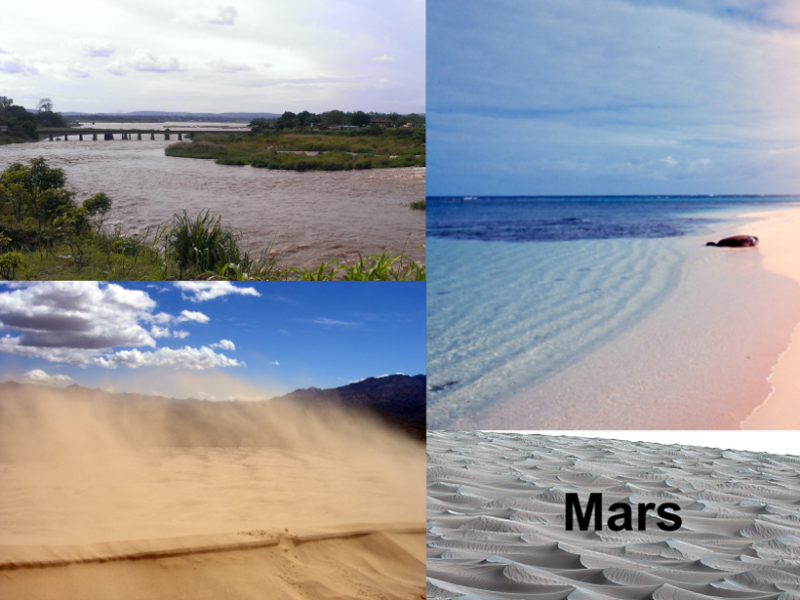Geomorphologists seek to understand why natural landscapes look the way they do. Key to this is understanding sediment transport, especially the thresholds at which sediments start and stop moving, and the rate at which sediments move around in different conditions. A recent article in Reviews of Geophysics presented an overview of the physics of sediment moved by wind and water. Here, the authors give an overview of advances in our understanding of sediment transport.
What are the main ways that loose sediment becomes mobile and moves around natural landscapes?
The surfaces of many different natural landscapes, including deserts, riverbeds, and ocean floors, consist of loose sediments. When a fluid flows over these surfaces, sediment grains can become mobilized and transported by the flow. For example, rivers transport sediments to the oceans, where currents can direct them to coastal areas, from where wind can blow them landwards.Small grains can be suspended by the flow (e.g., atmospheric dust aerosols), whereas large grains travel along the surface and, in doing so, can alter its morphology, giving rise to landforms such as ripples, dunes, banks, and barrier islands. There is evidence for sediment transport and its associated landforms not only on Earth but also on other Solar System bodies, such as Mars and Saturn’s moon Titan.
Are the physical processes that move sediment via wind and by water similar or different?
Both. In many ways, the physical processes are very much the same. A turbulent flow of a Newtonian fluid, described by the Navier-Stokes equations, interacts with granular particles, which form a bed under gravity and interact with each other following the laws of contact mechanics.
However, the phenomenology of sediment transport by wind and water are very different. Wind-blown sand grains tend to move comparably quickly and in characteristic large ballistic hops. Their impacts on the bed are more violent and often eject new bed grains into motion. In contrast, sand and gravel grains driven by a water stream tend to move more slowly in small hops or via sliding and rolling along the bed surface. Though their impacts are less violent, they are still able to drag, but usually not eject, bed particles out of their pockets.
What have recent developments in sediment transport experiments revealed?

Even arbitrarily slow viscous flows will eventually irreversibly change the locations of grains within the bed and at the bed surface (“creeping”), although this may take a very long time.
Furthermore, recent experiments have fundamentally changed our understanding of how grains resting on the bed surface become mobilized.
For example, the traditional viewpoint that one primarily must understand the flow forces or flow-induced torques acting on bed surface grains has been seriously challenged. Instead, it appears that the destabilizing effects of transported particles’ impact on bed surface grains are very important, even for water-driven sediment transport where these effects have typically been neglected. It has also been recently found that one must also account for turbulent eddies and the time they take to pass by a bed grain.
How have computer simulations helped scientists to better understand sediment transport processes?
Computer simulations allow studying sediment transport at the grain scale with direct access to most physical details. They thus have been used to understand how grain scale dynamics translate into an average continuum behavior, like the link between the mobilization of individual bed grains and the stability of the bed surface as a whole. Computer simulations also allow systematic exploration of sediment transport across a large range of environmental conditions.This has led to a much-improved understanding of the average threshold flow condition associated with sustained sediment motion.
First, computer simulations revealed that this “cessation threshold” seems to partially control many important statistical properties of continuous sediment transport, including its rate. Second, guided by computer simulations, general equations were derived that agree with cessation threshold measurements across sediment transport in oil, water, and air.
What are some of the unresolved questions where additional research, data, or modeling is needed?
One of the most important open problems is: why do arbitrarily slow flows cause an irreversible, albeit very slow, grain motion, even in the absence of turbulence?Much work also needs to be done to better understand the initiation of sediment transport, since our current knowledge suffers from two major problems.
First, for water-driven sediment transport, researchers using traditional experimental methods have often conflated multiple critical flow conditions. For example, the critical condition associated with sustained sediment motion rather than that which is associated with sediment transport initiation was measured, partially because these critical conditions were historically assumed to be the same.
Second, for wind-driven sediment transport, researchers traditionally used laboratory measurements of sediment transport initiation to draw conclusions about natural conditions. However, this practice is highly problematic as natural atmospheres have much larger boundary layers, allowing for stronger wind gusts at a given average speed.
—Thomas P?htz, (tpaehtz@gmail.com; ![]() 0000-0003-4866-3017), Zhejiang University, China; Abram H. Clark (
0000-0003-4866-3017), Zhejiang University, China; Abram H. Clark (![]() 0000-0001-7072-4272), Naval Postgraduate School, USA; Manousos Valyrakis (
0000-0001-7072-4272), Naval Postgraduate School, USA; Manousos Valyrakis (![]() 0000-0001-9245-8817), University of Glasgow, UK; Orencio Durán (
0000-0001-9245-8817), University of Glasgow, UK; Orencio Durán (![]() 0000-0001-8459-582X), Texas A&M University, USA
0000-0001-8459-582X), Texas A&M University, USA
